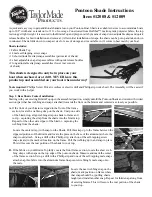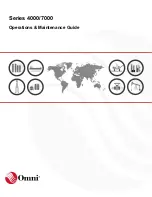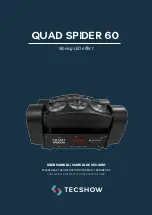
2
• Power injector machine pressure limiting feature may not prevent over-pressurization of an occluded catheter, which may
cause catheter failure.
• PowerPICC® Provena™ Catheter indication for power injection of contrast media implies the catheter’s ability to withstand
the procedure, but does not imply appropriateness of the procedure for a particular patient. A suitably trained clinician is
responsible for evaluating the health status of a patient as it pertains to a power injection procedure.
Sherlock™ Tip Location System (TLS) Warnings (Applicable to kits with Sherlock™ TLS Stylet)
• Ensure that the stylet tip does not extend beyond the trimmed end of the catheter. Extension of the stylet tip beyond the
catheter end, combined with kinking and excessive forces may result in vessel damage, stylet damage, difficult removal,
stylet tip separation, potential embolism and risk of patient injury.
Precautions
General Precautions
• Sterilized by ethylene oxide. Do not re-sterilize.
• Carefully read and follow all instructions prior to use.
• Caution: Federal (U.S.A.) law restricts this device to sale by or on the order of a physician.
• Caution: After use, this product may be a potential biohazard. Handle and dispose of in accordance with accepted medical
practice and applicable local, state and federal laws and regulations.
• Only qualified health care practitioners should insert, manipulate and remove these devices.
• Follow Universal Precautions when inserting and maintaining the catheter.
• Follow all contraindications, warnings, cautions, precautions and instructions for all infusates, including contrast media, as
specified by their manufacturer.
• Precautions are intended to help avoid catheter damage and/or patient injury.
• Use aseptic techniques whenever the catheter lumen is opened or connected to other devices.
• Examine the package carefully before opening to confirm its integrity and that the expiration date has not passed. The
device is supplied in a sterile package and is non-pyrogenic. Do not use if package is damaged, opened or the expiration
date has passed.
• Inspect kit for inclusion of all components.
• Accessories and components used in conjunction with this device should incorporate luer lock connections.
• DO NOT USE A SYRINGE SMALLER THAN 10 mL TO FLUSH AND CONFIRM PATENCY. Patency should be assessed with a
10 mL syringe or larger filled with preservative-free 0.9% sodium chloride (sterile saline). Upon confirmation of patency,
administration of medication should be given in a syringe appropriately sized for the dose. Do not infuse against resistance.
• Prolonged infusion pressure greater than 25 psi may damage blood vessels or viscus.
• Some patients may be hypersensitive to heparin or suffer from heparin induced thrombocytopenia (HIT) and these patients
must not have their catheter locked with heparin flush solution.
• As reported in literature, anaphylactic or anaphylactic-like reactions occur in a small percentage of the population during
placement
1
, positioning
1
, flushing
2
of central venous catheters or cleaning of catheter exit site
3
. These reactions are
reported in association with insertion, rapid flushing, or manipulation of the catheter and/or use of chlorhexidine gluconate
(CHG) in some patients. Be aware of the potential symptoms or signs of these reactions and take precautionary steps as
dictated by institution protocol for their prevention or treatment.
• If CHG allergy is suspected, confirmatory testing is recommended
4,5
.
• Secure additional extension sets per hospital protocol. Refrain from having unsupported extension sets that could put stress
on the catheter extension leg(s).
Precautions Related to Device Placement Procedure
• The PowerPICC® Provena™ Catheter features a reverse-taper catheter design. Placement of larger catheters at or below
antecubital fossa may result in an increased incidence of phlebitis. Placement of the PowerPICC® Provena™ Catheter above
antecubital fossa is recommended.
• Avoid placement or securement of the catheter where kinking may occur, to minimize stress on the catheter, patency
problems or patient discomfort.
• Flush each lumen of the catheter with sterile saline prior to use. Catheter stylet must be wetted prior to stylet repositioning
or withdrawal.
• Do not advance the guidewire past the axilla without fluoroscopic guidance or other tip locating methods.
• If the guidewire must be withdrawn while the needle is inserted, remove both the needle and wire as a unit to prevent the
needle from damaging or shearing the guidewire.
• Never use force to remove the stylet. Resistance can damage the catheter. If resistance or bunching of the catheter is
observed, stop stylet withdrawal and allow the catheter to return to normal shape. Withdraw both the catheter and stylet
together approximately 2 cm and reattempt stylet removal. Repeat this procedure until the stylet is easily removed. Once
the stylet is out, advance the catheter into the desired position.
• Avoid accidental device contact with sharp instruments and mechanical damage to the catheter material. Use only smooth-
edged atraumatic clamps or forceps.
• Avoid perforating, tearing or fracturing the catheter when using a guidewire.
• Avoid sharp or acute angles during implantation which could compromise the patency of the catheter lumen.
• Do not use scissors to remove dressing to minimize the risk of cutting catheter.
• Do not suture through or around any part of the catheter’s tubing (shaft or extension legs). If using sutures to secure
catheter USE THE SUTURE WINGS and make sure they do not occlude, puncture, or cut the catheter.
• The catheter must be secured in place to minimize risk of catheter breakage and embolization.
• To reduce potential for blood backflow into the catheter tip, always remove needles or syringes slowly while injecting the
last 0.5 mL of flush solution.




























